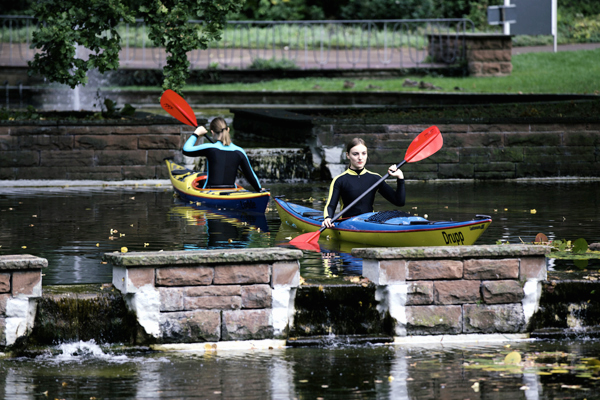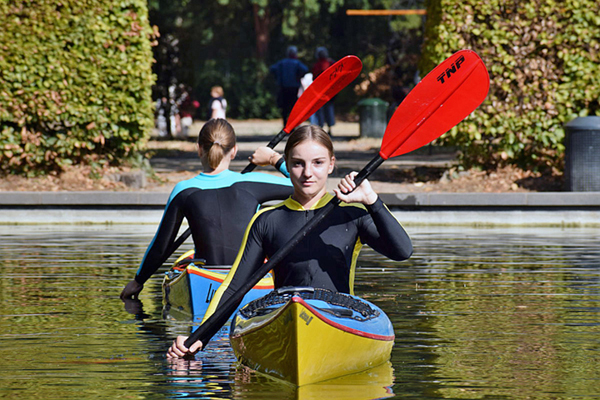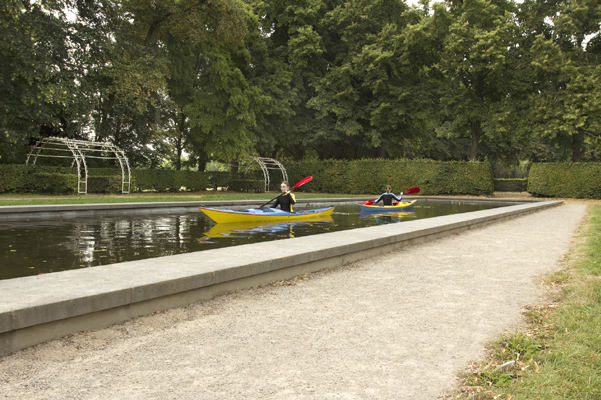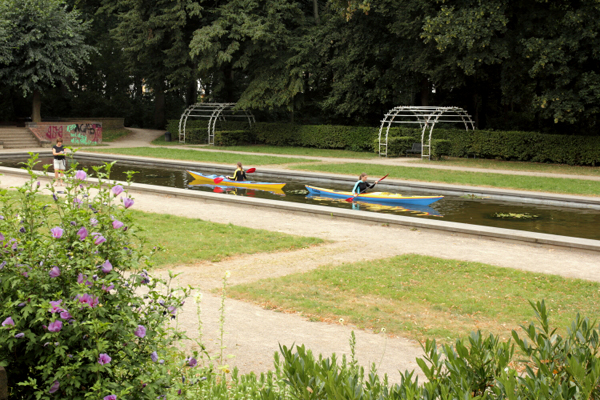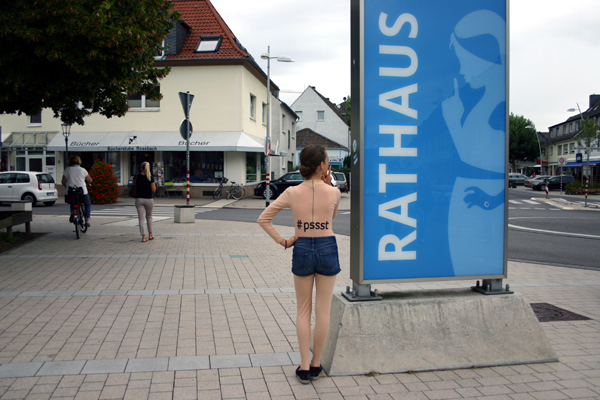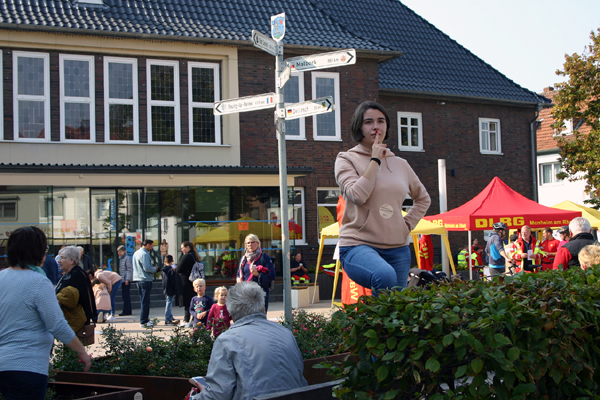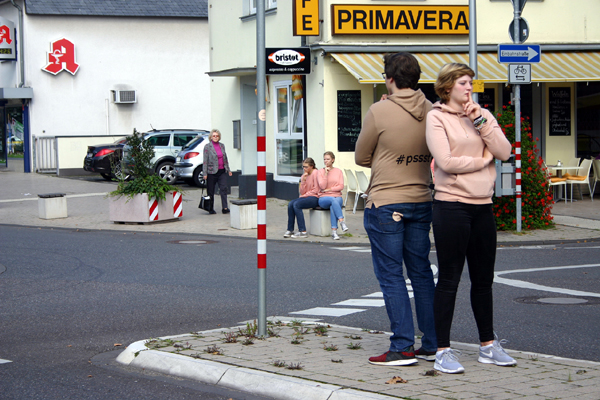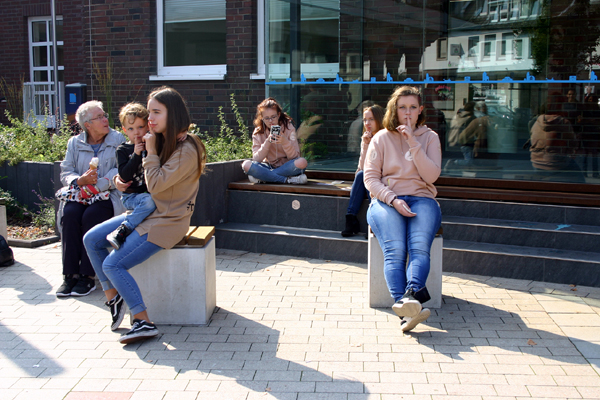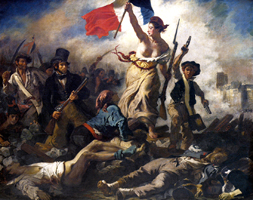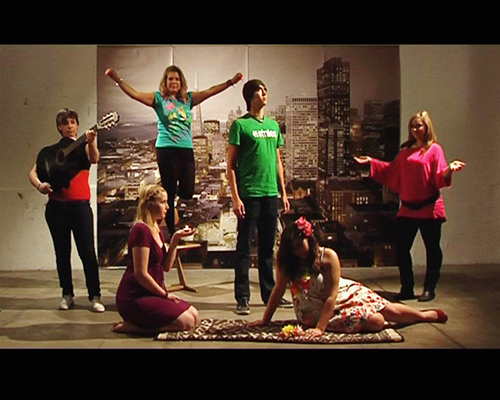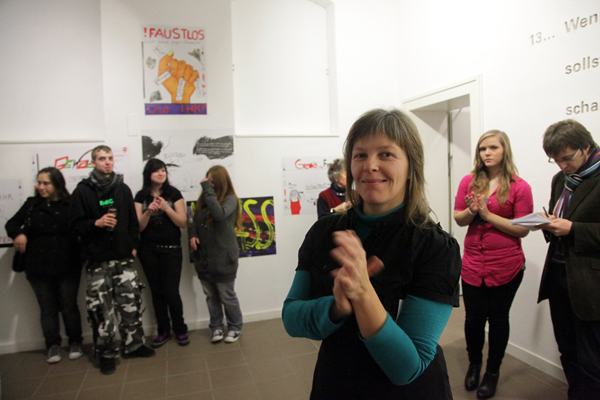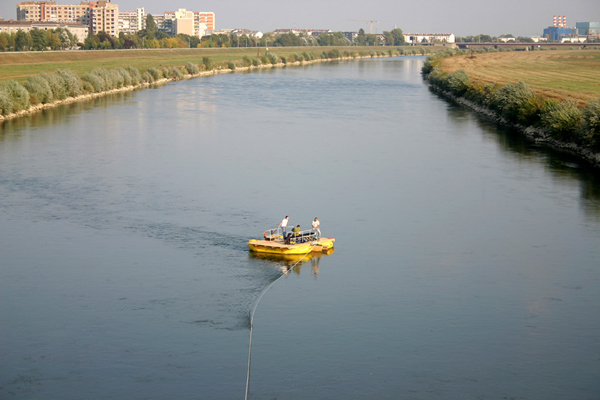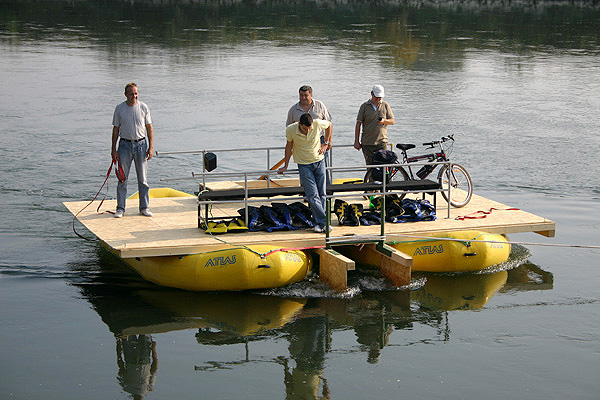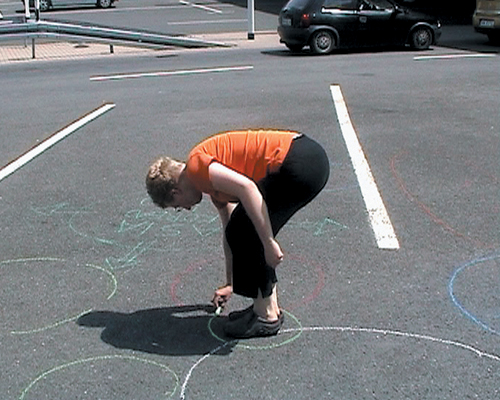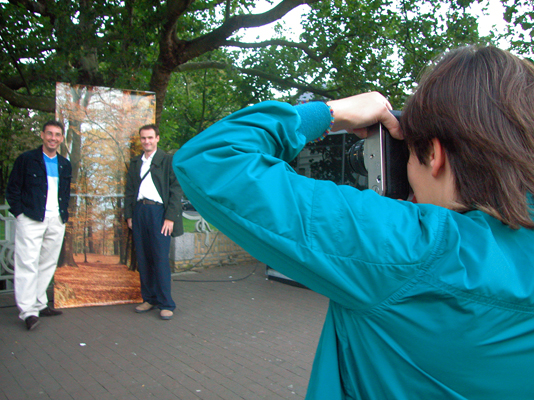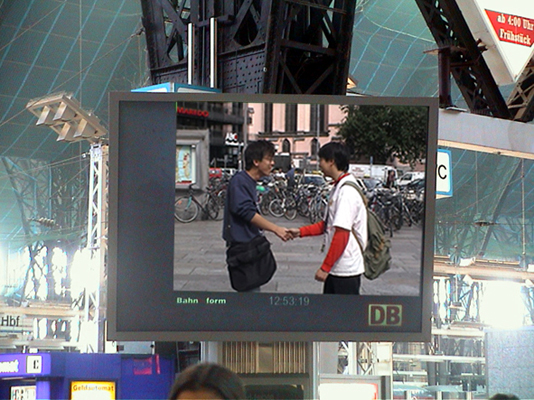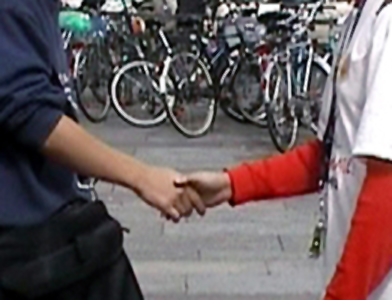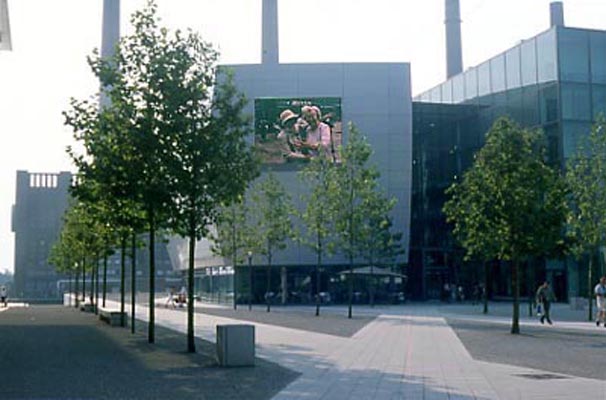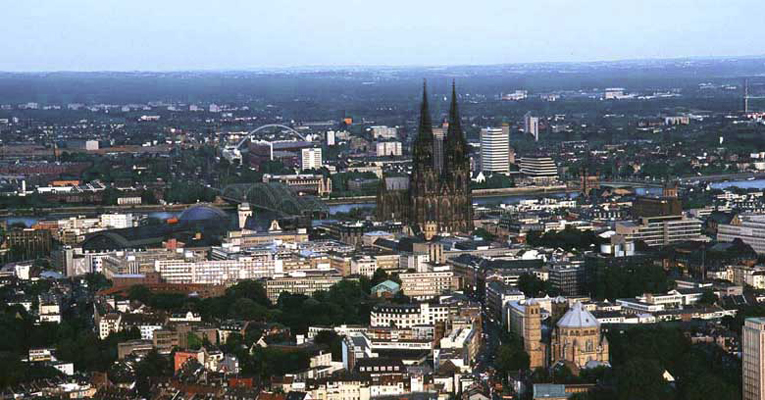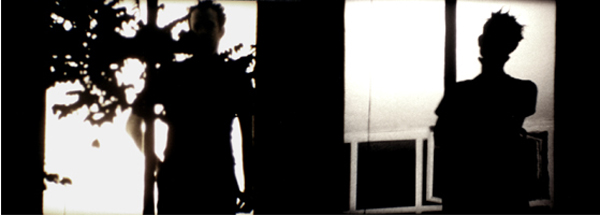Interventions and Participatory Projects in Public Space |
|
Target practice / Zielübung (2019) Performative installation in public space shown on 28th of September 2019, in the water basin of city hall park in Göppingen, Germany in the larger context of Unscharp, the 3rd Art Prize of the Evangelical Church in Württemberg at Kunsthalle Göppingen. Two kayakers, sisters Carla and Jule from Paddel-Club-Köln, trapped in the basin stay in balance for one hours without movement, against the flow of running water. The installation includes audio that comes originaly from a meditation music for professional athletes which serves for self-optimization. The overall installation provides concious an absurdistically surreal image in the public park. |
|
Target practice / Zielübung (2018) Performative intervention/installation in public space shown on the 2nd of September 2018, in the water basin of Vorgebirgspark Cologne, Germany during the Vorgebirgspark Skulptur 2018.
Two kayakers, sisters Carla and Jule from Paddel-Club-Köln, stay in balance for more than six hours without movement, focusing the geometrical axis of the park. The installation includes audio that comes originaly from a meditation music for professional athletes which serves for self-optimization. The overall installation provides concious an absurdistically surreal image in the public park. See video documentation: target practice 2018 |
|
#pssst took place in the context of "Stadtbesetzung: Körperkunst II" (City occupation: Body art II), organized by the Kultursekretariat NRW Gütersloh. The motivation of the performative city occupation in Monheim on the Rhine is, for me, the best-known Monheim's landmark, the mother goose (Gänseliesel), who wants to get her geese to hold the beak with the gesture of the left index finger held in front of her lips. With the gesture of the historical figure of Gänseliesel, the performative manifest #pssst calls for silence in the bustle of everyday life, particularly on the Election Day, 24th of September 2017, and cause us to "pause" for a moment - think about what we say (and do). The main actresses are groups of young people, who are distributed in the most diverse places throughout the city, with the gesture of the pointing finger before the mouth. As a closed group, they slowly move through the streets of the inner city, distribute stickers with words of positive action instructions as a "help" for a peaceful, democratic cohabitation. The final takes place before the Schelmenturm, another Monheim landmark. The 26-meter-high tower was built around 1425 to protect the freedom of Monheim as part of a fortification. There, a voice choir meets, whose exclamations of linguistic contrast pairs are interspersed with chatter of the geese and the interjection "pssst" in an audio installation. |
#pssst (2017) Performance-manifest and audio installation in public space to the parliamentary elections on the 24th of September 2017, Germany.
|
|
|
|
|
Die Freiheit führt die Jugend (Liberty leading the Youth, 2011) video installation / procces based participatory project
Re-enactment of the historical painting “Liberty Leading the People” by Eugène Delacroix (1830)
Liberty Leading the youth used the famous historical painting "Liberty Leading the People" (1830) by Eugène Delacroix as a starting point for a performative re-enactment with inverse signs. The in oil painted political poster of the French Revolution shows like no other picture of art history that violence and revolution are related and that the Western pictorial tradition, which is full of battle scenes, contains of no visual alternative to violence. |
During a performance workshop, I asked the young participants in a studio situation, to develop a peaceful variant without militant items for staging, to transform the image to an own statement of liberty in daily life of young people. The process of content and formal approaches to revolution/violence/freedom is documented in the form of a "making-of" video and shown as a videoinstallation |
Gewalt.Frei (2011), is a violent preventive, participatory project with children and young people aged 10 to 21 years, produced in cooperation with Kristina Leko (HR/D). |
|
Logbook Sava (2009) Temporary intervention in public space / participatory mobile audio-installation at Urbanfestival 09 in Zagreb. At the spot where there used to be a ferry that connected the two banks of the Sava, visitors are invited to cross the river with the sound installation Logbook Sava. |
During my research stay in Zagreb, I noticed that there's just one pedestrian bridge crossing the Sava (“the magical border”). In order to encourage communication and exchange between residents of the old part of the city and New Zagreb, I’m building a ferry that connects very different neighbourhoods. The in situ intervention aims at permanently contributing to the promotion of the community. While the passengers slowly and leisurely cross the river on the ferry, they are listening to a radio play made up of songs about the Sava and Zagreb as well as excerpts of interviews made during the research that contain wishes, fears and dreams of Zagreb’s inhabitants. During the journey the passengers are left to contemplate and can leave a note in the logbook at the end of the journey. |
Grenzmarkierungen-Köln / Border marking Cologne (2008) Participatory fieldwork / artistic research / intervention in public space / poster campaign presented at Plan08, Cologne |
|
Grenzgänger / Grenzzieher (2001-2004) Crosser of Borders / Creator of Borders (2001-2004) These participatory, performative media-art installation in public space is a project in co-operation with Olaf Hirschberg (Cologne), is a confronting examination of the societal and self-imposed borders of our individual realities. An evocative and complex installation, first presented in a waiting room of the Cologne central train station and currently placed in a window-shop of ARTWALK (Amsterdam), is the result of a unique discussion between us and the Archbishop of Cologne, Cardinal Meisner. After a sustained dialogue with the Catholic Church, we organized a meeting with the Cardinal to engage him in an exchange on the subject of borders, using two of our own artworks as catalysts for debate. The conversation and photographic portrait taken during the encounter come together in this piece, a reflection on the position of the artist, the power of the symbolic and the potential of the viewer as a dynamic giver of meaning. The work’s inexorable gaze forces us to deal with the entanglement and intersection of borders in the textual and visual components of the piece itself, but also to question our own interpretations of image as truth and consensus as identity. Cologne Central Station, waiting-room, platform no.1 |
|
Individual Borders (2003), developed in the context of [ve]01: border counter, a project that gathers together different experiences of border crossing along two pre-determined routes: Berlin - Venice / Jerusalem - Venice. Curated by Multiplicity and Officina Plug-in. Travelling by car along the trajectory between Berlin and Venice, I crossed various kinds of borders, both on peripheral and main roads between: Germany / Czech Republic, Czech Republic / Austria, Austria / Slovenia, Slovenia / Italy. Along these borders, I approached people on the street and asked them to define their own personal border around themselves, while in front of the official one. I offered them a box full of different coloured chalk with which to draw their borders on the street. Individual Borders is a participatory videowork and at the same time an intervention in public space. Most of the 40 participants instinctively defined their personal borders in a public space as a circle around themselves.
|
Individual Borders (2003) presented at [ve]01: border counter by Multiplicity, Utopia Station, Arsenale, La Biennale di Venezia 2003 |
|
|
|
Backgrounds (2002), is a participatory photo project and performance in public space that took place on the Witte de Withstraat in Rotterdam, in the larger context of the Bodycase project, a manifestation conceived by Gil & Moti Homegallery. I asked passers-by to pose in front of a background chosen from eight different images; a selection out of a group of 1970s wallpaper landscapes. After making their selection, individuals were juxtaposed alongside the "real" street environment. Fifty people participated in the performance and subsequently received their own photo via email. The project examines our role in the spectacle of daily life and the way in which we are constantly confronted with our ambivalent position within it. We roam the urban landscape, bombarded with an incessant flood of irritations, all the while trying to maintain a sense of self. In this piece and much of my art, I investigate the psycho-geographic behaviours that stem from these daily confrontations and try to offer people a way to escape and re-focus on their personal positions amidst their sometimes mindless daily actions. |
|
Meeting Point (2002) |
My particular approach to audience can also be seen in Meeting Point (2002), a video project and intervention in public space which in 2002 takes the form of projections on the Bahninform information-screens in 26 rail stations at the same time in Germany. Video sequences, 60 acts of greeting between people from various cultures and generations in public spaces, are displayed on the Bahninform in between the regularly scheduled information and entertainment programs. Travelers in the train station are confronted, in a vivid way, with personal gestures of others who are also in public situations. I was very conscious about "giving it back" to those who participated in the original recording of the video segments. I think the work in itself has to meet people. |
Meeting Point Mobil (2002) Screening on LED wall ZeitHaus, Meeting Point Mobil commissioned by VW Ausostadt Wolfsburg, Germany
|
|
|
Cologne: Foresight / Insight (2000) In this interactive internet piece, I visualized a network of representative people of economical, political and cultural power in the city of Cologne. Playing the role of a mediator between public and private, I filmed these individuals shaking my hand, an inevitably intimate and sometimes awkward gesture. |
|
|
Gil & Moti Homegallery, first floor, two 16mm film projections on windows
Inside Out (1999) a site-specific, participatory audiovisual installation at the Gil & Moti Homegallery in Rotterdam examines the diverse roles and positions of spectators/participants, and the relationship between the private and the public. After interaction and dialogue with individuals and business owners living on the Witte de Withstraat in Rotterdam, I placed monitors in people's homes and businesses, showing the interior life of the space (previously recorded video created in collaboration with the inhabitants) to the world on the street outside. |
|
